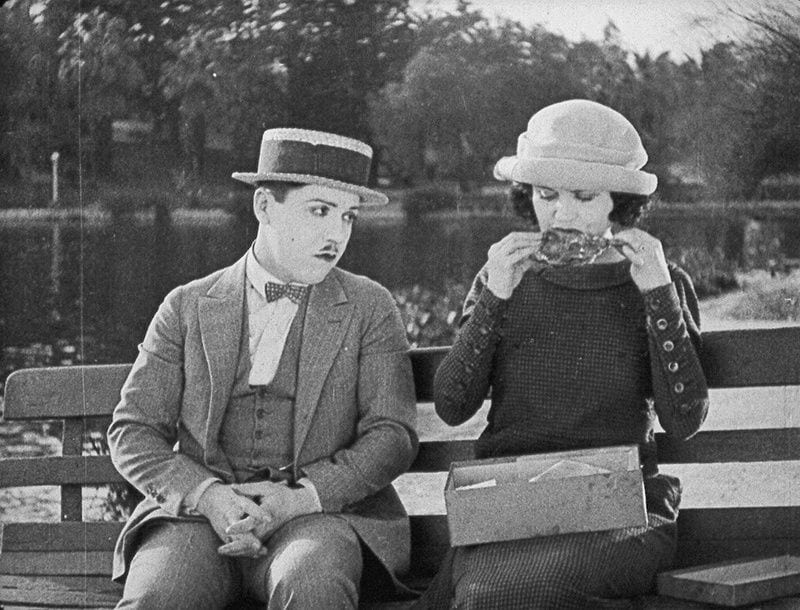
Sponsored by the Library of Congress, Mostly Lost is an annual film workshop in which unidentified or mis-titled silent films are screened to an audience of scholars and fans who try to figure out what they are. Sometimes they succeed. PopMatters reviewed Volume One of these rarities, and now comes a second made-on-demand DVD: Found at Mostly Lost, Vol. 2, containing ten newly identified films from the festivals of 2015 to 2017.
While all have historical or social interest, at least half also retain their ability to delight. None have been restored and upgraded in any way from the prints as they exist, but all have new piano music from Ben Model, Andrew E. Simpson, and Philip Carli. The program doesn’t arrange the films chronologically but rather alternates light and serious fare for the sake of variety. We, however, will address them in chronological order as nearly as possible.
The earliest film here, possibly dating from 1903 (though it proclaims a 1902 patent date), is from Thomas Edison’s company. Tentatively labeled Adolph Zink, it stars the titular vaudeville performer, a little person whose act consisted of imitations. In what was evidently a multimedia spectacle, he would leave the stage between routines and the audience would be shown a film of how he was changing into a new costume in his dressing room. These 11-minutes of film consist of four of those quick-change anecdotes. They involve him being costumed in drag by a regular-sized dresser, getting into a fight with a cop over a cigar, and, in a medium closeup, applying clownish makeup.
Online research indicates an illustrated 1896 page from The Peterson Magazine declaring “A band of foreign players who have won success in America for many seasons past are the German Liliputians… Their productions are always spectacular, with elaborate scenery, mechanical effects and handsome ballets. The three most prominent members of the company are Adolph Zink, Franz Ebert and Selma Goerner. Little Herr Zink is slim and lively as a cricket; his work is always intelligent and his dancing very clever… The production, new this season, is entitled ‘Merry Tramps,’ and it affords this trio excellent opportunities for good work in their respective lines.”
Alas, another online source from 1896 is the San Francisco Call of 15 December. The headline “Lilliputians land in jail” explains that three of the troupe, including Zink and Ebert, were held in jail over a lawsuit while the rest of the troupe had to leave town for their next engagement. The suit was brought by New York playwright Adolph Phillips. Everything must have been worked out and Zink chose to remain in America, where he became a popular vaudeville performer.
An excerpt from page 247-248 of Performing New Media, 1890-1915 (Indiana University Press, 2014) edited by Kaveh Askari and others, explains “Beginning in 1900, actor Adolph Zink performed a quick-change act in vaudeville, entering and exiting the stage to perform ‘live’ impersonations, then making his costume changes while a motion picture displayed his supposed antics with his dresser backstage: Zink, a ‘little person,’ combines gags about his size, boyish appearance, pugnacity (reported in newspapers), a ‘No Smoking’ sign, and the cross-dressing material in his act. The photographic quality of the surviving Edison film at the Library of Congress… suggests it may be a remake of Zink’s original film, perhaps circa 1903 when Zink and his manager, Edwin Miner, won a federal lawsuit and took advantage of the resulting publicity.”
The page goes on to identify the figures impersonated by Zink in the film, as recorded in the lawsuit testimony that was brought about by one Hattie Delaro Barnes, stating that she originated the idea of incorporating quick-change films into her stage act in 1897. She charged copyright infringement. “The judge questioned the morality of Barnes’s act, which showed her undressing down to her bloomers in the film”. Fascinating — another forgotten woman film pioneer? Meanwhile, one can find other tantalizing references to Zink; perhaps some enterprising researcher will devote an article to him now that this film is readily available.
One of the most delightful films in the set is the imaginative and uproarious And the Villain Still Pursued Her; or, The Author’s Dream (1906) from trick-film and animation pioneer J. Stuart Blackton at Vitagraph Studios. Starring Paul Panzer, it combines mockery of melodrama, dream surrealism, trick editing, grotesquely violent slapstick (far in advance of the Three Stooges), cut-out animation and superimposition effects as three figures (including a man in drag?) pursue each other. More than 110 years later, it remains a dazzlingly creative spectacle, unfortunately in rough shape.
From an unknown director, The Faithful Dog; or, True to the End (1907) is a French tearjerker about a blind beggar and his useful and loyal poodle.
Having initially been misnamed “The Friendly Indian”, James Young Deer’s The Falling Arrow (1909) is one of the many “Indian romances” created by this actor-filmmaker with his wife Red Wing. The primitive tableau style of films from this decade means that we don’t get the closeups we’d like in the course of the simple story about our Indian hero (recognizable by his feathered head-dress) rescuing his Felice (Red Wing) from a polecat called “Jim the Outlaw”. The plot is exactly the type mocked in Blackton’s film of three years earlier. The kidnapped maiden signals her plight with a carefully aimed arrow that apparently travels a colossal distance. One medium closeup of Young Deer and Red Wing makes us yearn for more, for they are a handsome couple of an ethnicity we’re not used to seeing in stars from early films, although these two made many.
Another western made one year later, William F. Haddock’s In the Tall Grass Country (1910), is notably more sophisticated in story and style. Francis Ford, who would soon become a successful director himself (and was John Ford’s older brother), stars as the tall cowpoke whose visiting sister provokes a misunderstanding with his sweetheart (Edith Storey), who summons her better nature to rescue the wrongly perceived rival from a brushfire. Another “friendly Indian” shows up to play a part in the rescue, and his shirtless portrayal is unusual for showing him to be much more convincingly muscular and outdoorsy than was often the case at this time.
We now skip more than ten years to the anonymously directed The Noodle Nut (1921), a comedy with dapper little go-getter Billy Bletcher as an office boy making good in a noodle factory and winning his girlfriend’s hand against a large rival. Much humor comes from the constant crushing of five-foot noodles, which are samples intended to tempt client Mack A. Roni. Possibly no symbolism is intended. Yes, it’s silly but amiable and in good shape.
Another slapstick riot with a dapper little hero is the anonymous Derby Day (1922) with Monty Banks. He chases after a box of food (with much undercranking), then gets dragged under a car before saving the day as a jockey in a horse race. This amusement is a German print with untranslated intertitles, not that it’s hard to follow.
At 22-minutes, the longest film here is of uncertain date but clearly from the ’20s. It’s also the only tinted film and boasts a print of marvelous clarity, and it’s kind of wonderful. From an unknown director, The Sunshine Spreader begins as another parody of old-school melodramas. We’re told “Susie Summers has a weakness for spreading sunshine.” As she charms her way resourcefully through a plot full of romantic characters at cross-purposes, she emerges as a smart heroine.
We’re given some actor names but not which roles. Mae Hotely must be the destitute widow. Helen Foster seems to be our heroine’s duplicitous rival. Charles Force would seem to be the rival’s father, while Tiny Sandford is the hulking father of the callow youth loved by Susie. So who’s the youth? And who’s our heroine? And though I hardly think it’s possible, there’s a brief vivid appearance by a customer who bears a strange resemblance to Fanny Brice. Even when the film is right in front of us, silent cinema remains full of mysteries. This film may no longer be lost, but much of its information seems to be. This is why researchers and scholars keep on trucking, and why fans keep on watching.



